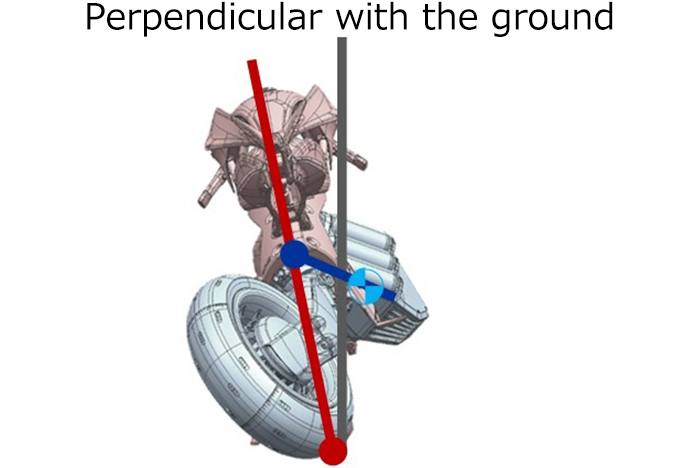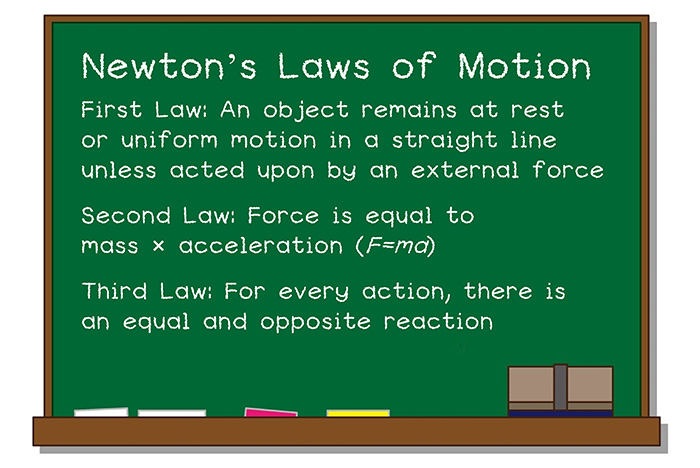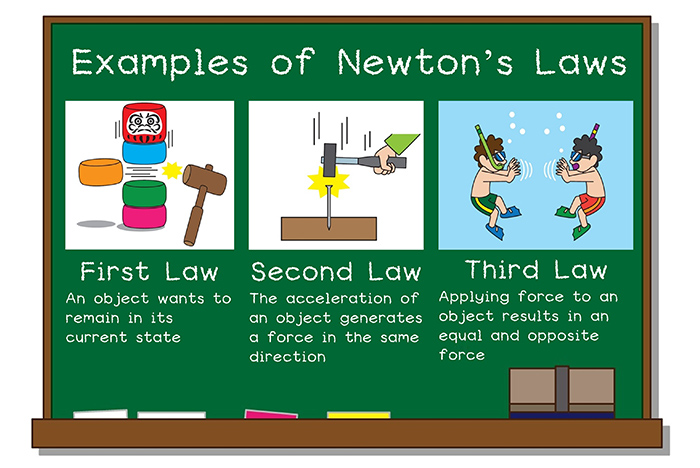Newtonian Mechanics in Our Waza and Sube
Introducing the stories behind Yamaha Motor's technologies.
Yamaha Motor technologies can be broadly classified into three areas: powertrains, chassis and hulls, and electronic control. The Seeds of Creation website introduces various examples of the techniques (waza) and skills (sube) behind Yamaha technologies, but their origins can be traced to Isaac Newton, a mathematician, physicist and astronomer from England who lived in the 17th and 18th centuries.
It is said he began to contemplate the existence of what we now know is gravity after seeing an apple fall from a tree in his garden. Even today, some 300 years after his passing, Newtonian mechanics form the basis for explaining all manner of phenomenon, from common items around us to medicine and space exploration.
Newtonian mechanics are based on his three Laws of Motion as shown on the blackboard (#1).
The First Law states that an object remains at rest or uniform motion in a straight line unless acted upon by an external force. At that time the object will remain in that state of motion unless a force acts to change the motion.
The Second Law states that force F is equal to mass m × acceleration a (F=ma). In other words, the acceleration of an object depends on the net force acting on the object and the mass of the object.
And the Third Law states that for every action, there is an equal and opposite reaction.
Let’s take a look at the relationship between these laws and the technology of Yamaha’s products.
Newton’s Second Law (F=ma) as Seen in a Piston
Yamaha has developed scores of engines since it was founded, and while each has its own characteristics, they are all based on Newton’s First and Second laws.
Let’s see how the Second Law relates to the operation of a modern engine. When riding a motorcycle at a steady speed, the engine also rotates smoothly at a steady speed, but the piston is actually not going up and down at the same speed. As the piston reciprocates inside the cylinder, its velocity is zero at the very top (top dead center) and bottom (bottom dead center) of its stroke and quicker mid-stroke (#2). That is, its velocity varies and that change is called acceleration. Further, acceleration is greatest at the instant the piston’s velocity reaches zero.
Visualize a hammer striking a nail. The instant the hammer hits the nail, the hammer’s velocity is zero. Because its acceleration is greatest at this instant, the maximum amount of force is generated and the effective weight of the hammer’s head is multiplied several times (#3).
Going back to the piston, let’s break it down with the F=ma equation from Newton’s Second Law. F is the force generated by the piston (inertial force), m is the piston’s mass and a is acceleration. So, m × a = the force generated by the piston. For this reason, if the piston’s mass is reduced by half, the force generated by the piston will also be halved.
It is commonly said that making the piston lighter reduces its reciprocating weight, but this in turn also reduces the force it generates. However, lighter pistons offer many benefits such as reducing the load on connecting rods and other engine components, enabling higher rpm, reducing vibration and mechanical noise, and improving reliability.
Newton’s Second Law is what led Yamaha engineers to design lighter pistons. This is why lightweight, forged aluminum forged pistons* are widely used in high-rpm motorcycle engines.
*Forged pistons: Pistons are the heart of an engine and are made of aluminum. There are two ways to shape aluminum into pistons. One is casting, in which the aluminum is melted and poured into a mold and cools to solidify into the desired shape. Another way is forging, in which the aluminum is heated and pressed into a mold to form the shape. With forging, the aluminum is not melted when it is formed so the density of the aluminum’s crystalline structure is retained, resulting in thin, lightweight pistons.
For more on our casting and forging operations:
OEM Casting and Forging

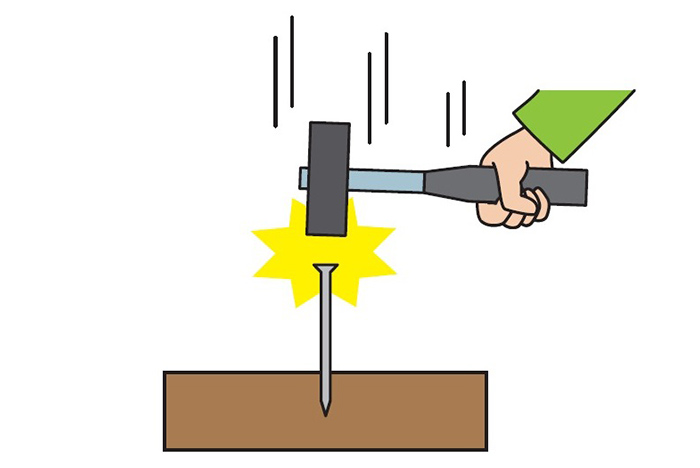
Newton’s First Law in Engines
Yamaha engines reflect Newton’s First and Second laws in other ways also, like the offset cylinders employed in our outboard motors and the YZF-R1 motorcycle to our “BLUE CORE” technology for small-displacement engines and the crossplane crankshaft featured in models like the YZF-R1 and MT-10. Let’s take a closer look at the crossplane crankshaft (#4).
As you know, the motion of the piston caused by combustion is converted into rotational force at the crankshaft via the connecting rod. However, this crankshaft rotation is not generated only by the force of combustion. The crankshaft also generates a varying force as it rotates, independent of combustion conditions. That is, the piston’s inertial force also plays a role in rotating the crankshaft. This is called “inertial torque.”
During each rotation, the crankshaft accelerates and decelerates, meaning there are variations in the amount of inertial torque. By eliminating these fluctuations, the crossplane crankshaft delivers linear power characteristics.
Look at the picture of two people riding a tandem bicycle (#5). In the upper picture, the pedals are always in the same position for both riders while in the lower one, they’re at different positions for the front and rear rider. In the first picture, it would likely take some time for the riders to get the bicycle going from a complete stop. But in the second picture, the pedals are offset by 90° so you can imagine that the bike would be propelled smoothly in the same case. The idea is that the upper illustration is like a conventional in-line 4-cylinder engine while the lower one is like a 4-cylinder engine with a crossplane crankshaft.
This layout delivers smooth crankshaft rotation, but as stated in Newton’s First Law, an object will try to retain its current state at a given time. This crankshaft design was born of a thorough understanding and application of this Law.
For more on the crossplane crankshaft:
Yamaha Technology: Crossplane Crankshaft

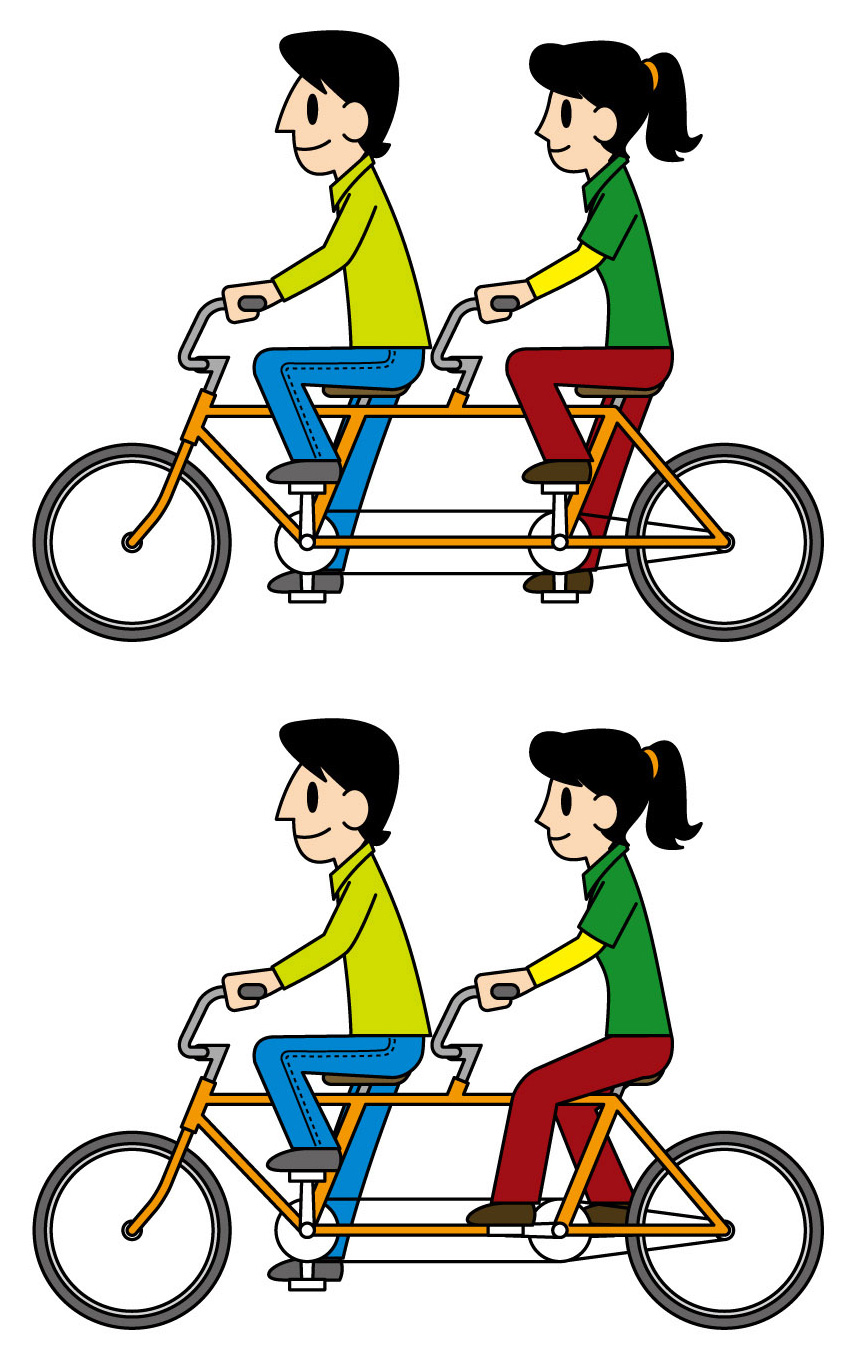
Chassis and Newton’s Third Law
Newtonian mechanics are also reflected in Yamaha’s chassis and hull technologies with designs based on his Third Law for action and reaction. An easy way to visualize this is to imagine two swimmers underwater in a pool (#6). If one pushes the other, the reaction will force him in the opposite direction. Let’s see how the Third Law applies to Yamaha products.
Our Leaning Multi-Wheel (LMW) design is a good example. This technology came about from our engineers’ aspirations to enable vehicles with multiple wheels to still lean through turns and deliver the fun of a conventional motorcycle, and is one addition to the “growing world of personal mobility” envisioned by Yamaha.
The LMW design responds to the road surface or chassis lean by having the left and right front tires move in a seesaw fashion; when one wheel rises the other goes down (#7). This movement is controlled by the system’s parallelogram link. The part’s parallelogram shape ensures that the surrounding linkages (and the wheels by extension) remain parallel, even when force is applied to only one side. This is an excellent example of action/reaction (#8). A pushing force on the object is accompanied by an equal reactive pushing force, while a pulling force is accompanied by an equal reactive pulling force. The design of the parallelogram link so central to the LMW platform was the result of an in-depth re-examination of Newton’s Third Law and numerous tests and analyses.
There is also a constant action/reaction between tires and the road surface, which makes acceleration and deceleration possible (#9). Also, the suspension has springs which act and react to road irregularities to absorb bumps, so this process is occurring all around the chassis.
In this way, the spirit of Newtonian mechanics is alive and well in both the Tricity and NIKEN LMW models (#10).
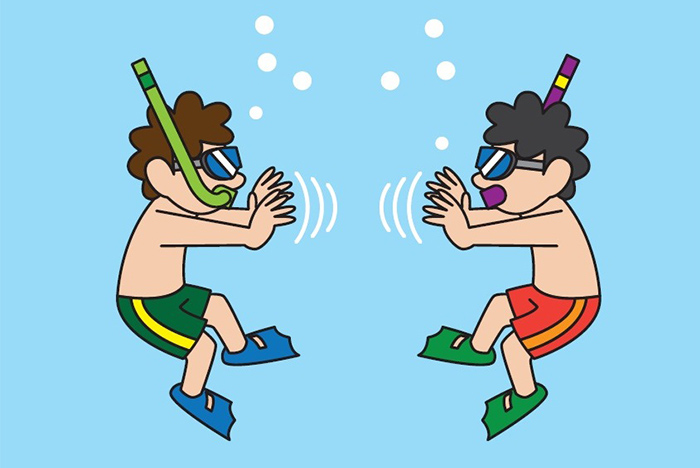
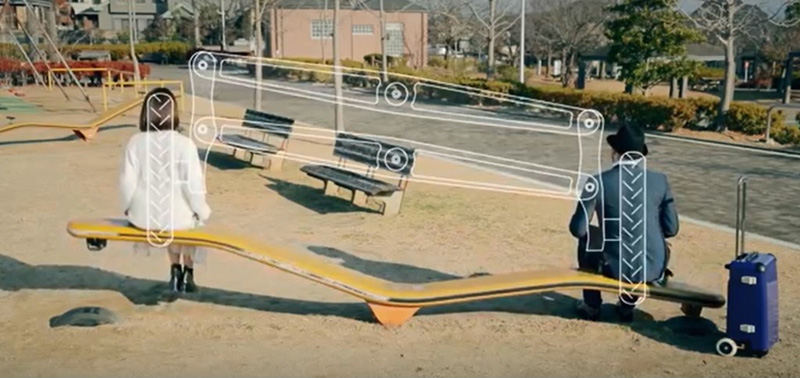

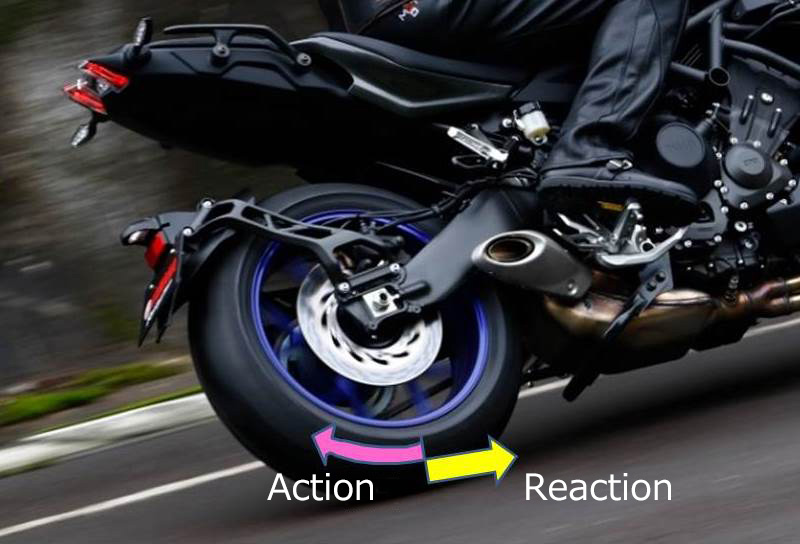

Electronic Control and Newton’s Second Law
MOTOROiD is a proof-of-concept prototype first exhibited at the Tokyo Motor Show in 2017 and garnered significant attention (#11). Aimed at creating new forms of personal mobility in which the rider resonates harmoniously with the machine and to create a new Kando* experience, it features artificial intelligence and autonomous technology to achieve a high degree of control over its balance and attitude. This machine can sense its own state and adjust its center of gravity to rise off its kickstand and remain upright at a standstill unassisted (#12).
*Kando is a Japanese word for the simultaneous feelings of deep satisfaction and intense excitement that we experience when we encounter something of exceptional value.
One of the key technologies that makes the new layout and construction of MOTOROiD possible is the Active Mass CEnter Control System (AMCES).* AMCES electronically controls the positional relationship between MOTOROiD’s center of gravity and the front and rear wheels’ contact points with the ground. Newtonian mechanics is at work here too. It is like balancing a broom or stick upright in the palm of your hand (#13).
*This technology is aimed at stabilizing two-wheeled vehicles by using electronics to actively control the chassis itself and constantly optimize the vehicle’s attitude.
Why do motorcycles fall over in the first place? While few ever think about this patently obvious question, we revisited the heart of Newtonian mechanics and applied our techniques (waza) and skills (sube) to it. In fact, in developing AMCES, Yamaha engineers devised a formula to express what happens when a bike falls over—the “F=ma of motorcycle falls” so to speak. Applying this formula allowed Yamaha to clarify the physics behind a motorcycle losing balance and falling over, and by working in reverse, the engineers were able to come up with a design that would allow the motorcycle to stand up on its own instead. This was then made to be controlled electronically. MOTOROiD is one example of how this approach was put to practical use.
The data from MOTOROiD’s various sensors is sent at a rate faster than once every 0.0005 seconds to the main control unit, which then relays instructions to the actuators that rotate parts of the chassis around the AMCES axis (#14) with high precision to control the machine’s center of gravity. The premise for this control is Newton’s F=ma equation. You could say that MOTOROiD’s very development concept is based on Newton’s laws governing the application of force to an object to generate acceleration and make it move.
Newtonian mechanics transcend centuries and continue to be reflected in many Yamaha products. As one Yamaha engineer remarked, “Newtonian mechanics may be the ultimate development methodology.”
For more on MOTOROiD:
Examining MOTOROiD
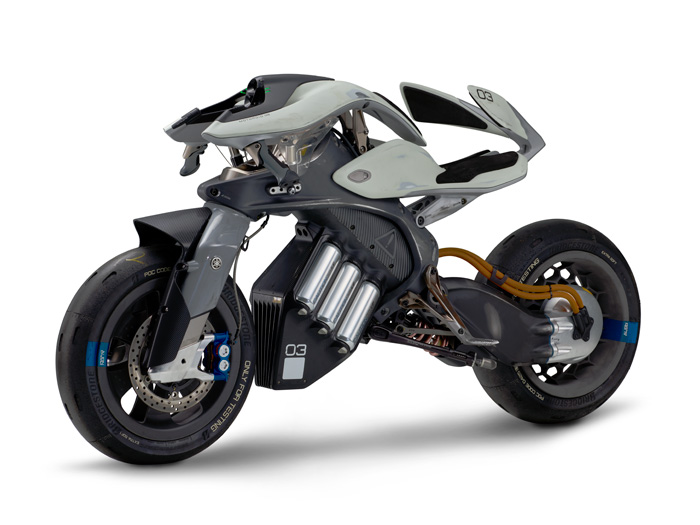
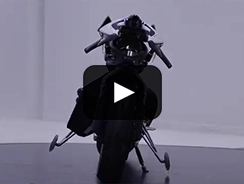
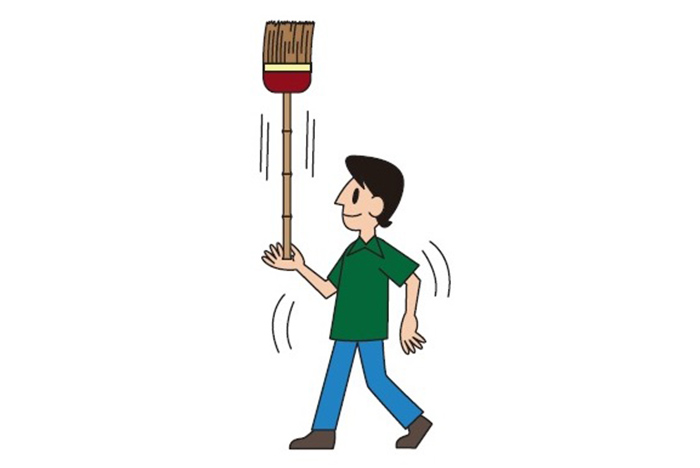
(#13)When the palm holding the broom and the broom’s center of gravity fall out of balance, the broom falls over. Based on this principle, MOTOROiD places a counterweight spindle near the middle of the broom’s center and moves it accordingly to maintain balance.
